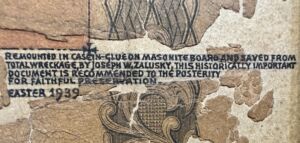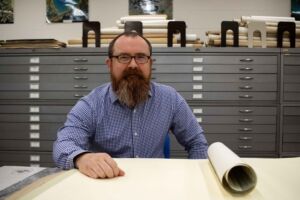
Note from one of Hennepin History Museum’s former directors, Joseph Zalusky, written on framed 1861 map of St. Anthony and Minneapolis.
…Or why we deaccessioned an 1861 St. Anthony-Minneapolis Map
One answer to the question above is, I hope so, and hopefully for the better. Another possible answer is, maybe not, the past is in the past. The question came to mind because an item in our collection has recently found a new home. An 1861 Rufus Cook map that used to be in our collection now resides at the University of Minnesota’s John R. Borchert Map Library. The history of our organization was influential in determining the future of this item. I’ll explain how that came to be, but first I’ll fill you in on the item itself.
The Map
The map was made by Rufus Cook, brother of Franklin Cook. His name is on a number of Hennepin County and Minneapolis maps. Rufus and his brother Franklin were civil engineers from New Hampshire, who arrived in Minneapolis in 1857 and got to work surveying. While Brother Franklin was tasked with saving the Falls of St. Anthony (he built the St. Anthony Falls apron), Rufus was credited with making the first map of Hennepin County (1860). He completed the map of St. Anthony and Minneapolis with property boundaries and ownership details in 1861.
The version of the map we had was framed (and possibly found) by Josephy Zalusky, one of the museum’s previous directors. The note in the image above says he rescued it from “total wreckage” in 1939. One can tell from Zalusky’s note that rescue entailed mounting the document to Masonite board. I love that he’s speaking to us from the past here. Zalusky commands us to preserve it for all time, for all posterity. Please disregard any snarkiness in my tone, but I guess he didn’t know how tough preservation is for items of this size, weight, and construction. Nor that once paper (cotton and linen) and Masonite are bonded with glue, they are virtually inseparable without damage to the paper. The acidity in the paper increases because there’s lignin in both board and paper. Add to that the off-gassing from glue and other materials in the board, and things start to brown within a few years. It’s also likely that the hardboard flexed, further damaging the map and perhaps obscuring some of the writing and instruction Zalusky so carefully made.

Joseph Zalusky added a quote from a 1939 Minneapolis Journal article from by Merle Potter and one from a Minneapolis Tribune article of the same year about Minneapolis landmarks to the bottom of the framed map.

University of Minnesota Map and Geospatial Information Librarian Head Ryan Mattke poses for a portrait in the John R. Borchert Map Library on Thursday, May 18, 2023. (Photo/Adria Carpenter)
Our Choice
So what’s a small (but mighty!) museum to do? This item is potentially beyond preservation and needs the attention of a conservationist, or even restoration(ist?) if it’s not too far gone. Regardless of the tasks needed, the care of this item is beyond our ability in-house. Enter our friends at the University of Minnesota.
The reason the map was on my radar at all was because Ryan Mattke, head of the University of Minnesota Borchert Library inquired about it. In the past, Mattke has digitized larger maps, some of which you can find here on MNCollections. On my way out of one of those digitization sessions, he casually asked if I’d seen an 1861 Franklin Cook map in color, mentioning that he’d only seen a black and white (sepia) copy in 2 parts. I said I’d check. Sure enough, after a couple weeks of digging around, I found one. I found THE one from which UofM’s copy was made because Zalusky’s notes were on it. The item was, as I mentioned glued and framed, leaning against the wall with some other large framed items. The map in the frame is 55” x 66”. I’m only 62”, and there’s no storage space in our archive to accommodate my height, let alone 4 inches more. This item needed more care than we could give if it was going to survive, so I asked Ryan is he was open to a transfer. Thankfully, he responded with a “yes.” It took a bit of time to get staff and board of directors to understand that I was pushing for the best outcome for this item rather than keeping it because it was historically valuable. After the message got through, we did the transfer.
Going Forward
This brings me to part two of this post. In some museum and archive circles, items are carefully chosen before accessioning, they are then properly cared for and stored for their entire lifecycle. If I were an historical document, that would be my ideal life, but some documents are not so fortunate. Let’s say their lifecycle has some dysfunction. Their environment is not ideal for their condition. They could be in cramped or tight conditions, or not supported properly. They could be too chilly in winter, or too warm in summer. Perhaps they need TLC, or an influx of cash to get on their feet. Or, they are displaced and need to find their forever home. Archival documents, like people, need the right conditions to flourish. Flourish in this case means preserved and accessible for as long as possible.
A big part of archiving items is preserving them. An overview of the care and feeding of an archival document, or collection of documents looks a bit like this after intake:
- assessment
- accession
- processing and preservation steps
- arrangement and organization
- description
- digitization* – we don’t have a program for this, it’s case by case.
- storage
- security
- climate control and monitoring
How the Cook map came to be leaning against the wall is a mystery. But it’s evident (because there is no evidence on this item) that some steps were skipped and the map fell through the cracks.
Unfortunately, there are more cases like this in our collection – some items are lost until found. Our goal is to have physical and intellectual control over all the items in our collection, but it will take much more time, effort, and money.
I completed a collection assessment in April of this year. One tool I used to discern the value of current collections was to position it against our vision and mission:
Our Vision: History unites communities when everyone is represented.
Our Mission: We preserve and explore history, creating spaces where our communities’ stories can be told.
Viewing the collection through this lens was helpful in that it revealed gaps in our collection. We knew they existed, but weren’t aware of how broad the gaps were. If we are to fix these issues, we have to address the space with which we have to work. Can you see where I’m going? In order to create “spaces where our communities’ stories can be told,” we have to literally create space.
Deaccession is not necessarily a nice word in the museum world, but it is necessary at times. The “D” word can carry with it connotations of yard sales and history in dumpsters, but the best possible deaccession IS a transfer, thankfully one that we were able to execute in the case of Mr. Zalusky’s map.
The Society of American Archivists offers guidelines for museums like ours to make decisions around deaccessioning collections. Here are a few:
- Would this collection and/or potential users be better served elsewhere?
- What condition is the collection in?
- What are the preservation/maintenance costs?
- What is the potential research value?
- Is the collection (or item) comprised of formats not generally collected by the repository, such as newspaper clippings, magazines, or artifacts?
- Does the collection contain reproductions or copies of materials that are located elsewhere?
- Is the collection or series restricted under federal or state law? If so, can portions of it be opened to researchers?
We are a ways away from where we need to be, but as we grow into a better organization, we will have to make more tough decisions, create policies to guide us, and leave good notes for those who follow after us. So, yes, I believe we can change our history, we just can’t change all of it, only the parts for which we’re responsible. Thank goodness for notes from the past to show us a way forward. 🎤
-Michele Pollard | Hennepin History Museum Archivist
Sources:
Minnesota Territorial Pioneers Souvenir No. 2. 1901. B38.6. Hennepin History Museum.
